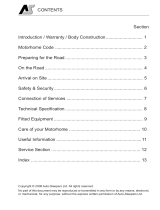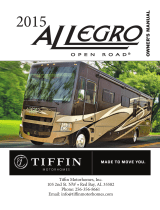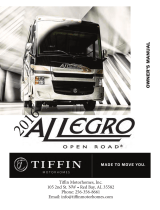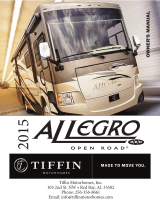Page is loading ...

USER MANUAL - 2018 COLLECTION

Standard motorhome confi guration
The pictograms and di erent areas shown on this basic diagram
do not necessarily refl ect the layout of your motorhome.
Baggage
compartment
230 V connection Water heater
draining
Fresh water inlet Fuel fi ller cap
Garage space Wastewater tank Cassette toilet Control panel Battery
unit
Fire extinguisher
(depending on country)
Gas
compartment
Despite being the exclusive property of Pilote Group, the photographs and illustrations published here
are not contractual. Pilote reserves the right to modify, add or remove components or technical
characteristics at any time, without notice, for the sole purpose of improving the quality of its products.
Despite the care taken in preparing it, this catalogue is not a contractual document.

3
1 - Welcome
1.1 Welcome aboard! ......................................................5
1.2 How to use this manual ............................................5
1.3 Legal framework ........................................................7
1.3.1 Regulations .............................................................7
1.3.2 Warranty .................................................................. 7
1.4 Motorhome manners ............................................... 8
1.4.1 General principles .................................................8
1.4.2 Parking .....................................................................8
1.4.3 Waste........................................................................9
2 - Discover your motorhome
2.1 The base .................................................................... 10
2.1.1 The chassis ...........................................................10
2.1.2 The wheels ...........................................................10
2.1.3 The accessories ..................................................10
2.2 The living area ..........................................................11
2.2.1 Hatches, openings and valves ......................... 11
2.2.2 Boots and storage compartments ................ 11
2.2.3 Interior layout ...................................................... 11
2.3 Basic fluid diagrams ................................................12
2.3.1 Water system .......................................................12
2.3.2 Electrical system .................................................13
2.3.3 Gas ........................................................................17
2.3.4 Ventilation, heating system .............................. 18
2.4 Safety ........................................................................ 19
2.4.1 Fire ..........................................................................19
2.4.2 Gas .........................................................................19
2.4.3 Electrical system ................................................ 20
2.4.4 Emergency exits ................................................ 20
3 - Preparing to travel
3.1
Servicing after a an extended stationary period
.... 23
3.1.1 Drinking water ..................................................... 23
3.1.2 Refrigerator.......................................................... 23
3.2 Fill up and levels ...................................................... 23
3.2.1 Fuel ........................................................................ 23
3.2.2 Tyre pressure ...................................................... 23
3.2.3 Drinking water .................................................... 24
3.2.4 Gas ........................................................................ 24
3.2.5 Battery .................................................................. 25
3.3 Practical and emergency equipment .................. 25
3.3.1 Bulbs ...................................................................... 25
3.4 Load ........................................................................... 26
3.4.1 Technical specifications ................................... 26
3.4.2 Calculating loads ................................................27
3.4.3 Storing baggage ..................................................27
3.4.4 Trailer..................................................................... 28
4 - Travelling
4.1 Safety checks before departure ........................... 30
4.2 Adjustments ..............................................................31
4.3 Driving........................................................................31
4.4 Authorised seats.......................................................31
5 - Stops and parking
5.1 Choosing a spot ...................................................... 33
5.2 Safety when stationary .......................................... 33
5.3 Supply systems ........................................................ 33
5.3.1 Turning on the water ........................................ 33
5.3.2 Turning on the gas ............................................ 34
5.3.3 230 V power system ......................................... 34

4
5.4 Draining .................................................................... 35
5.4.1 Wastewater .......................................................... 35
5.4.2 WC ......................................................................... 35
5.5 Insulation .................................................................. 35
5.6 Locking ..................................................................... 35
6 - Using the equipment
6.1 Openings .................................................................. 36
6.1.1 Windows ............................................................. 36
6.1.2 Rooflight .............................................................. 39
6.2 Kitchen ......................................................................40
6.2.1 Sink ........................................................................ 40
6.2.2 Extractor hood (optional) ................................. 41
6.2.3 Gas-powered appliances .................................41
6.3 Table ......................................................................... 45
6.3.1 Table attached to vehicle side ........................ 45
6.3.2 Central table with fixed base .......................... 46
6.3.3 Table with folding extension ...........................47
6.3.4 Table with retracting extension ......................47
6.4 Television ..................................................................48
6.5 Car radio, car radio DVD player and GPS ...........48
6.6 Reverse camera .......................................................49
6.7 Bathroom .................................................................50
6.7.1 Shower and washbasin ..................................... 50
6.7.2 WC ......................................................................... 50
6.8 Sleeping area ........................................................... 50
6.8.1 The coachbuilt area .......................................... 50
6.8.2 Dinette sleeping area ........................................51
6.8.2 Pull-down bed ................................................... 52
7 - Maintenance and winterisation
7.1 Gas installation ........................................................ 57
7.2 Maintenance of the interior .................................. 57
7.2.1 Cab..........................................................................57
7.2.2 Cushions, mattresses, curtains........................57
7.2.3 Maintenance of the windows ..........................57
7.2.4 Furniture ............................................................... 58
7.2.5 Bathroom fixtures .............................................. 59
7.2.6 Cooking appliances .......................................... 59
7.2.7 Refrigerator ....................................................... 59
7.2.8 Water heater ....................................................... 59
7.2.9 Control panel ...................................................... 59
7.3 Cleaning the exterior .............................................. 59
7.3.1 Washing the bodywork ..................................... 59
7.3.2 Tar ..........................................................................60
7.3.3 Small scratches ..................................................60
7.4 Winterisation or long stops ................................... 61
7.4.1 Batteries .................................................................61
7.4.2 Water ..................................................................... 63
7.4.3 Turning o the refrigerator .............................. 64
7.4.4 Ventilation device ............................................... 64
7.4.5 Cushions, mattresses, curtains ....................... 64
7.4.6 Repairs ..................................................................64
8 - List of dealers
8.1 Dealers in Europe .................................................... 65
8.2 Dealers in France .................................................... 73

5
1 - Welcome
1.1 Welcome aboard!
Dear Sir or Madam,
Thank you for choosing Pilote.
It is very important to read this user manual carefully as well as the instructions provided with all the fittings: refrigerator, water
heater, heater, oven, etc.
Proper use of your motorhome will aord you a superior level of comfort while preserving the value of your vehicle.
The Pilote network and the Pilote Customer Relations department are at your disposal (see contact details in chapter 8).
Any infringement, translation or copy of all or part of this document is strictly forbidden. Any full or partial copy requires our
prior written permission.
Enjoy your trip with your Pilote motorhome.
1.2 How to use this manual
Always keep the user manual to hand in the motorhome and inform the other users of the safety instructions. This document
contains some important remarks concerning personal safety. You should read them carefully. Below you will find the
meanings of the various pictograms used in this document.

6
Warning, risk of injury
If you ignore this remark, you may place yourself
or other people in danger.
Warranty restriction
Warning, you may restrict or lose the warranty
if you do not heed these recommendations.
Cold weather use
Beware of hazards caused by cold weather.
Protecting the environment
Certain uses or handling may cause damage to the environment.
Further information
These remarks provide further information
or draw your attention to useful details.
Warning, risk of property damage
If you ignore this remark, you may damage the appliance(s) concerned.

7
1.3 Legal framework
1.3.1 Regulations
The vehicle must be registered according to the regulations. There are no specific regulations that apply to the use of
a motorhome. Motorhomes are both vehicles and a form of accommodation that are subject to the following codes,
depending on the country:
• the highway code when driving the vehicle
• general local legislation and the highway code when parking on the public highway
• urban land use code when parking on private property.
1.3.2 Warranty
• The warranty, guaranteed by the dealership, lasts 24 months from delivery and key handover. The date is specifically
mentioned by the dealer in the box reserved for the purpose on the warranty certificate.
• The warranty only applies to the living area as well as to any transformations made by GP SAS to the chassis base; the chassis
part is covered by the car manufacturer warranty.
• The warranty should, as far as possible, be redeemed by the dealership where the vehicle was purchased, both for the living
area itself and for defective parts that may be changed separately.
• The motorhome shall be made available to the dealer for any exchange or repair. No refund shall be made for the cost of
transport to and from the dealer (both for the motorhome and the people) or other related expenses incurred directly or
indirectly.
• If household appliances are covered by their own manufacturer's warranty (fridge, heating system, etc.) then contact your
nearest brand representative (see list of representatives provided with the appliance) or, where this is not possible, your Pilote
dealer.
•
It is important to fill out the warranty documents for appliances when provided and to return them to the various
manufacturers.

8
The warranty will not apply in the following cases:
• The buyer has not complied with the instructions for use
• The motorhome has been modified by a non-approved person or by installing non-original parts
• The damage or the defect is due to failure to observe the Highway Code
• The damage results from improper or negligent use
• Normal wear and tear
• The motorhome was repaired in a workshop not approved by GP SAS or without its prior written agreement
• The motorhome has been transformed or equipped with accessories not fitted by the manufacturer and which are liable to
aect key vehicle characteristics
1.4 Motorhome manners
1.4.1 General principles
Good motorhome owners are discreet and must be careful not to leave any trace of their stay. Motorhome owners must
have good manners, respect others and protect the environment. The use of a motorhome as accommodation implies
respecting the rules with regard to the inhabitants of the places visited.
1.4.2 Parking
In city centres and urban areas, it is advisable to find parking in sparsely populated areas and to avoid obstructing the visibility
and conducting of business, so as to ensure the motorhome does not constitute an obstacle to circulation. Likewise, using
motorhomes as accommodation shall take place in such areas:
• without spreading to the area around the vehicle
• without causing inconvenience to residents
• without monopolising the public area
• without allowing pets to run riot, foul or otherwise disturb the neighbours

9
1.4.3 Waste
Wastewater emptying must take place:
• In appropriate places and never near to housing, rivers, streams or crops.
• the emptying of "black" water (lavatory) into the rain water drainage network is strictly prohibited.
All water drainage valves must be closed whilst travelling. Even fresh water should be emptied discretely, to avoid suspicion.
It is always worth asking the local authorities about how to safely get rid of wastewater. Household garbage must be placed
in plastic bags and disposed of in designated places.
Wastewater must be drained o in appropriate places,
never near housing, rivers, streams or crops.
By observing all of these common-sense rules, everyone may fully enjoy the multitude of pleasures provided by the passion
for motorhomes.

10
2 - Discover your motorhome
2.1 The base
2.1.1 The chassis
The chassis number is located
on the right front wheel arch.
Your dealer should give you the user manual and the chassis maintenance book published by the car manufacturer when
your motorhome is delivered. We recommend that you take note of the contents and follow the instructions relating to
chassis. The wheel alignment is set by the chassis manufacturer before leaving the factory.
Chassis number
< on Low-Profile
Chassis number
on A-Class >
2.1.2 The wheels
See chapter 3 for the tyre pressure. In case of puncture, use the quick repair kit located in one of
the boots.
2.1.3 The accessories
Motorbike racks and coupling systems must be approved and fitted with the appropriate electrical
circuit.
These accessories reduce the load capacity of the motorhome and aect road handling.
The driver should adapt his driving or even reduce speed in some countries.
The wheel alignment must be imperatively checked at 1,500km (900 miles).
An additional verification is also strongly recommended at 20,000km (12,000 miles).
The cost for such inspections shall be borne by the user.

11
2.2 The living area
2.2.1 Hatches, openings and valves
Your motorhome has several types of openings on the outside:
2.2.2 Boots and storage compartments
Several interior and exterior baggage compartments are installed in your motorhome.
2.2.3 Interior layout
Your motorhome is made up of four equipment zones for your comfort and safety. The layout may dier according to the
models and the options delivered.
• Driving: seats fitted with safety belts
• Meals: table, seats, sink, cooking appliances, refrigerator
• Bathroom: washbasin, shower, WC
• Living room: TV fixture, cupboards
Opening lights
• Cab entrance door(s)
• Entrance door to living area
• Side window(s)
• Skylights (translucent)
• Access doors to storage
compartments
• Compartment door to cassette WC
for draining
Hatches
• Fuel
• Fresh water inlet
Drainage valves
• Draining the fresh water tank
• Draining the water heater
• Wastewater disposal
Ventilation devices
• Foul air grilles and/or ventilation
shafts (for cooking appliances,
refrigerator, heating system...
depending on the model)
• Devices integrated into the rooflights
and in the floor of the vehicle

12
Wastewater
The wastewater is collected in a
tank under the vehicle. It is drained
by means of a discharge valve
located behind the side skirt or in
the double fl oor.
2.3 Basic fl uid diagrams
Drinking water
Filling up is done using an external
nozzle fi tted with a locked cap,
identifi ed by a pictogram. The tank
is located in one of the bench-seat
chests or in the double fl oor.
Tank
draining
Water heater
purge
Wastewater
draining
Wastewater
tank
WC module
Fresh water
tank
DO NOT PIERCE THE FLOOR OF LOW PROFILE MOTORHOMES.
Tubing for evacuating gas and water are built into the fl oor.
Never make any alterations or modifi cations, except if performed by a recognised installer. .
2.3.1 Water system
Supply diagram

13
2.3.2 Electrical system
Supply diagram
The power supply is made up of a 230V alternating current part and a
12 V direct current part.
230 V supply
Connecting to the mains supply allows you to:
• recharge the leisure battery
• use power outlets
• run the refrigerator on 230 V
• operate the heating system if your vehicle is fitted with a 230V
heating system
12 V supply
The 12V power supply comes from two batteries:
the engine battery and the cell battery. The engine battery supplies
all electrical equipment in the vehicle section. The leisure battery
supplies the electrical appliances in the living quarters. It is placed in a
compartment. This battery is of the "semi-stationary" type. Under no
circumstances may it be replaced by a vehicle start-up battery. For
any replacement, please contact your dealer. The two batteries are
connected by a charger/coupler unit that maintains the charge via the alternator (motor running) or via the mains (230 V).
The electrical unit charger provides a booster charge to the battery when the motorhome is plugged into the mains. Under
no circumstances will this operation completely recharge a depleted battery.
Never carry out or allow modifications to installations and electrical appliances,
unless performed by approved fitters. A cable reel must be completely unwound
to prevent the electric power supply cable from overheating.
Incorrect assembly of the electrical and electronic accessories may seriously
damage the motorhome and lead to loss of warranty.
Circuit breaker
Sensors
Fresh water
tank
Wastewater
tank
Control panel
Electrical unit

14
Solar panel
A solar panel may be plugged into connector 2 of the electrical unit (option). It is important to correctly follow the assembly
instructions supplied by the solar panel manufacturer.
A cable is available between the control panel (above the unit door) and the electrical unit.
Generator set
When using a generator set, please carry out the following
steps in the right order:
• First start the generator set
• Connect the 230 V cable to the motorhome
The circuit elements
Electrical unit
The electrical unit includes a charger, a transformer (complete 12V distribution) and fuses (circuit protection). Depending on
the model, it is located either under the front right or forward-facing bench seat, in the storage compartment or behind a
removable panel on the front left side.
Circuit breaker
The circuit breaker is next to the electrical unit.
Sensors
The sensors measure the fresh water and wastewater tank
levels.
Solar panels often do not provide adequate additional charge when several electric appliances are
used simultaneously at night.
The current consumed should not
exceed 90 % of the nominal value
of the corresponding fuse on
the electric unit.
A generator set connected to
the motorhome’s 230 V system
must be perfectly adjusted (risk
of damage to the internal charger).

15
Fuses - Electrical unit
Description Function Location Amp Colour
F1 Leisure battery Fuse holder near the leisure battery 50 A Red
F2 Engine battery Fuse holder near electrical unit 50 A Red
F3 12 V refrigerator On the relay/fuse module 20 A Yellow
F4 Leisure battery detection On the relay/fuse module 2 A Blue
RL Footstep relay (according to model) On the relay/fuse module
Heating system Combined heating system/water heater Electrical unit 10 A Red
Light 1 Right side interior lighting Electrical unit 15 A Blue
Light 2 Left side interior lighting / Extractor hood* Electrical unit 15 A Blue
Auxiliary 1 Oven* Electrical unit 10 A Red
Outside light Awning light Electrical unit 5 A Orange
Electric bed Electric bed Electrical unit 20 A Yellow
Footstep Footsteps* Electrical unit 20 A Yellow
Auxiliary 3 No function Electrical unit 15 A Blue
Auxiliary 4 USB plug kitchen/living area * Electrical unit 15 A Blue
Auxiliary 5 No function Electrical unit 15 A Blue
Auxiliary 6 No function Electrical unit 15 A Blue
Television/ Antenna SAT 12 V socket TV Fuse holder near the cell battery 10 A Red
Over-cab bed Over-cab bed* Fuse holder near the leisure battery 25 A White
Pump WC / Pump Electrical unit 7.5 A Brown
Car radio Car radio power* Electrical unit 15 A Blue
Auxiliary 2
Car radio signal* Electrical unit 10 A Red
Fiat F49 fuse box 5 A Yellow
Refrigerator control panel
Automatic resettable polyswitch in the electrical unit.
2.5 A
Electric window command
and electric rear-view mirrors. Fiat fuse box (see manufacturer's manual)
* depending on options and models

16
The control panel
The control panel commands the electrical functions in the motorhome’s accommodation unit and displays the level of the
batteries and water tanks. It is located above the entrance door to the living area. See the manufacturer’s instructions for
operating the control panel.
Technical reservations
The motorhome’s electrical installation must comply with required standards. Any interference or modifications made to the
electrical installation may aect safety to persons and to the vehicle and is hence forbidden.
It is formally prohibited to carry out modifications to the control panel. Only qualified technicians are allowed to intervene on
the electrical connections, as specified in the manufacturer's assembly manual.
Service voltage
The rated voltage is 12 V.

17
2.3.3 Gas
Supply diagram
The gas pressure regulator may be equipped with an automatic inverter, depending on the models.
Connector hose
Pressure
regulator
Flow regulator with
manual reset
Installation
Your motorhome is fitted with a gas cupboard that
can hold two bottles, only one of which is connected
at a time. The gas bottles should be placed in the
external compartment provided for this purpose.
The installation operates only on propane, in all
countries.
The pressure for use is 30 mbar.
For all connections of additional elements on your
installation, consult your dealer (cf. manual delivered
with the motorhome).
• Do not change the type of regulator
• Do not use the apparatus under a dierent service
pressure
•
Change the flexible supply hoses (tubes) before
the limit date indicated with an approved model,
identical to the original.
Only qualified fitters
are authorised to work
on gas-powered appliances.

18
Gas system allowing heating while driving
The pressure regulator has a built-in impact detector. In case of an accident, with a strong deceleration, a mechanical protection
system cuts o the gas inlet. It complies with European regulations and allows you to use the gas heater while driving.
Apart from the heating, no other appliances are designed to be used when driving.
2.3.4 Ventilation, heating system
The existence of permanent upper and lower ventilation is essential in order to ensure constant air renewal.
• The lower ventilation is generally provided through a vent at the bottom of the furniture and in the floor.
• The upper ventilation is provided through the roof windows, which are permanently aired.
These devices enable natural air circulation, including inside the bench seats.
The ventilation devices should never be blocked, even during the winter.
They must be kept clean and dustfree.
The “Twiny” gas cylinder may not function properly in cold weather
when gas consumption is at a peak (heating system).
Use a 13kg bottle preferably, with the "Twiny" in reserve.

19
2.4 Safety
Never leave children unattended in your motorhome. This safety precaution is fundamental in a motorhome due to the
presence of medium and low voltage electrical appliances and gas-powered equipment.
Using the electric window command can be dangerous. Ensure that there is no risk of the passengers' limbs getting caught
in the electric window.
2.4.1 Fire
Provide an approved dry powder fire extinguisher with a capacity of at least 1 kg and familiarise yourself with the instructions.
Keep a fire blanket near the kitchen area. Consult the local fire safety measures.
Do not store aerosol cans in the motorhome; there is a risk that they could explode at temperatures above 50°C, which can
often occur in the summer. Never use cooking or heating devices other than those installed in the motorhome. If you must
plug in a cooking appliance or electric heater, it must work on the principle of direct radiation to avoid fire and asphyxia hazards.
Refer to “Emergency exits”, page 21, for a diagram of the emergency exit(s) in your motorhome.
2.4.2 Gas
Gas leak
If you notice the smell of gas, do not turn on lights, hand torches, lighters, matches, or any electrical item (e.g. switch), until
the smell disappears.
You should immediately:
1. Shut o the gas cylinders
2. Ventilate by opening all openings.
Keep away from the electric windows when they are operating.

20
2.4.3 Electrical system
Any modification or repairs to the electrical circuit carried out in a non-compliant manner or without taking account of
the technical specifications of the circuit may cause malfunctioning or a fire hazard. The liquid contained inside the leisure
battery, just like that in the main battery is toxic and corrosive. Avoid all contact with the skin or eyes. Keep the battery away
from flames, any source of sparks or aerosol cans : risk of fire or explosion
The battery is a dangerous piece of equipment and incorrect handling may provoke intense electric shocks. Keep the battery
away from flames or a lighted cigarette. Do not generate any sparks : risk of fire or explosion
2.4.4 Emergency exits
The diagrams below show the emergency exits in your motorhome, in accordance with the applicable regulations.
Always wear suitable eye protection when working on the battery or nearby.
/





